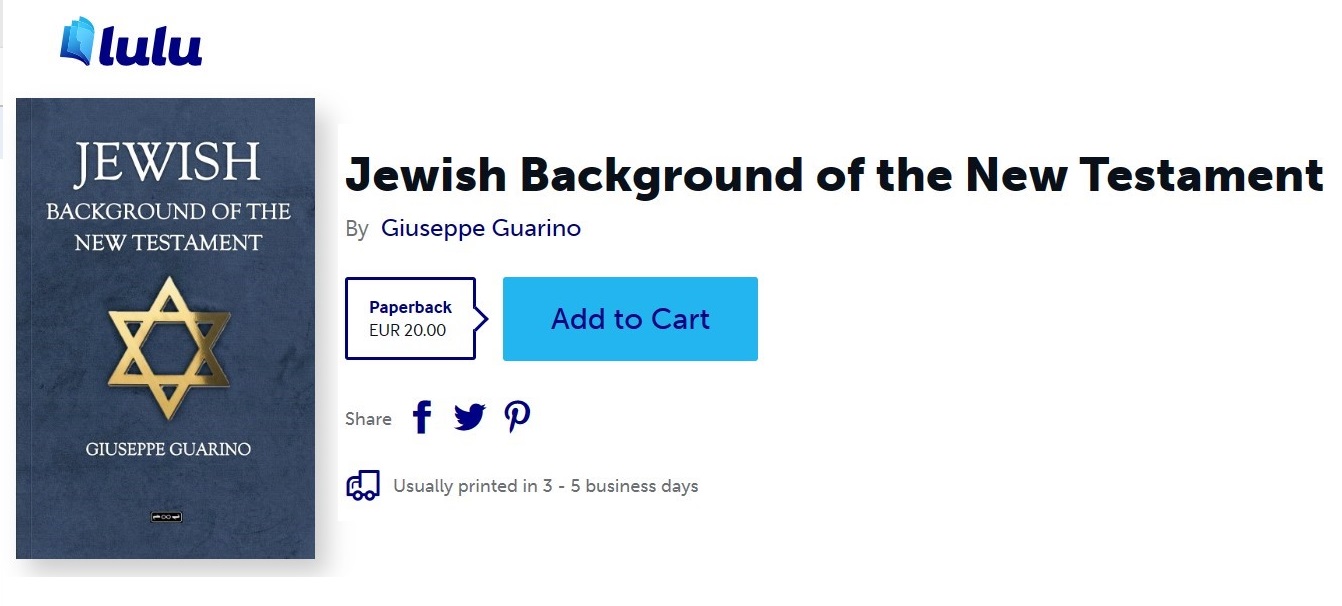by Giuseppe Guarino
The review of the relationship between Jewish faith and Christianity is relatively recent. A better and more concrete understanding of the meaning of Jesus’ mission and teachings requires accepting Jesus as a Jew, faithful to the Torah and, in turn, a rabbi and interpreter of it.
Time is increasingly revealing the groundlessness of those who strive to discredit traditional Christian faith. However, the absence of a concrete alternative is increasingly strengthening the historical reliability of the events that concern the life of Jesus and his teachings as found in the New Testament.
Labeling Jesus as Essene means not having understood the meaning of his teaching and having made Esseneism a static and uniform structure, which it was not. A double fatal error.
The teaching of the Essenes, the doctrine of the Pharisees, Sadducees, and other Jewish factions cannot be framed within rigid schemes but seen within the broad and varied reality that was Judaism in the first century. In other words, we cannot see the exclusivism characteristic of various expressions of Christian faith as a phenomenon that had parallels within the Jewish faith of the Second Temple.
The simple and devastating reality is that the correspondence of Jesus’ thinking with that of the Essenes was just as inevitable as his sharing many positions of the Pharisees or other factions of Judaism, simply because they all relied on the same principle on which Rabbi Jesus was based: the authority of the Torah and Jewish Scriptures in general.
Jesus found himself several times in favor of Pharisaic teaching against that of the Sadducee party, but it was an incidental issue and not a sign of belonging. The Lord did not hesitate to censure scribes and Pharisees, bluntly contesting the hypocrisy and useless ritualism they promoted, which ultimately ended up taking the place of genuine, sincere spirituality.
Jesus may have shared some positions of the Essenes when they legitimately took up some points of Jewish faith neglected by other factions of the time or Judaism in general. But he certainly was not an Essene, given the way his teaching differed from theirs. Jesus shared his table with sinners and was comfortable surrounding himself with all kinds of people. This is incompatible with Esseneism. Jesus’ polemic was even direct when he openly condemned hatred for enemies – which instead was promoted by Qumranian Esseneism.
Jesus was, therefore, a promoter of a new teaching, but deeply Jewish nonetheless. Framing Jesus within any of the religious factions of his time means denying the profound uniqueness of his teaching. On the other hand, separating him from the historical time in which he lived means denying the meaning of God becoming man, of the incomprehensible revealing itself, of the eternal wearing time and space to speak to man in the language of man.
To explain the meaning of God’s definitive Revelation in Christ, the Scriptures state: “God, after He spoke long ago to the fathers in the prophets in many portions and in many ways, in these last days has spoken to us in His Son, whom He appointed heir of all things, through whom also He made the world. And He is the radiance of His glory and the exact representation of His nature, and upholds all things by the word of His power. When He had made purification of sins, He sat down at the right hand of the Majesty on high.” (Hebrews 1:1-3 – New American Standard Bible)
There is something incredibly new in Jesus’ teaching compared to his predecessors. But this “new” is no less scriptural. In fact, there is nothing in the New Testament that is not deeply rooted in the Old. Indeed, the apostles announced Jesus as the Messiah in the light of the Jewish Scriptures. Even today, Jews converted to Christ use the Tanakh to claim the meaning of their faith in the Messiah, historicized in Jesus of Nazareth.
The New Testament was not intended for Jews, but for Gentiles; for this reason, it was written in Greek and became widespread among churches outside the Jewish sphere. Perhaps Matthew was the only account in the original Hebrew language tending to directly demonstrate to the Israeli people the messianic nature of Jesus.
Against historical and intellectual tendencies and conveniences, against sensationalism, the Christian faith today gains a better awareness of itself, which was already a heritage of the early Church.
Approaching the Gospel – the Christian announcement – and Jesus, two important characteristics must be taken into account: Jewishness and universality. If we only embrace the Jewishness of the Christian message, we risk being driven by the simple – and simplistic – desire to become Jews. However, embracing only the universality of the Gospel message without the awareness of how deeply its roots are Jewish, will make us lose sight of where we come from and where we are going.
Jesus was not an Essene, Pharisee, or Sadducee; he was Jewish, in the most religiously profound sense that this term can assume. This implied the substantial agreement with some aspects of Second Temple Judaism, but also the radical disagreement with the points where it had departed from the purity of Torah teaching and the trace left by the prophets.
Jesus interprets and lives Judaism in a definitive and authoritative manner, marking the end of an era and the beginning of something extraordinarily new: Christianity. The authority of the Old Testament is not denied in the New, but the announcement of the Master’s death and resurrection and his imminent return become the essence of the Gospel, of the good news, which eclipses every controversy and draws our attention to God’s invitation now addressed to every man, to accept His Love in Christ Jesus, our Lord and Savior.
“I have other sheep that are not of this sheep pen. I must bring them also. They too will listen to my voice, and there shall be one flock and one shepherd.” (John 10:16).”
To read more on this topic,
Buy it on Amazon or Lulu, following the links.
ebook: www.amazon.com/dp/B0BTN4C6KY
Buy the paperback clicking on the picture below


![Jewish Background of the New Testament by [Giuseppe Guarino]](https://m.media-amazon.com/images/W/IMAGERENDERING_521856-T1/images/I/41wxPOfrxSL.jpg)
